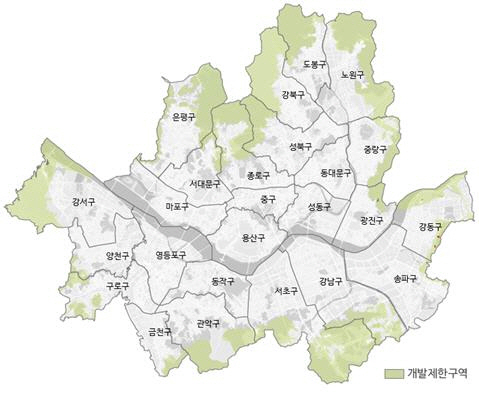 |
| Status of designation of development-restricted zones in Seoul |
AsiaToday reporter Chun Won-joon
The government has decided to lift restrictions on greenbelt or development-restricted zones in the capital area for the first time in 12 years, in order to stabilize the skyrocketing home prices in the region. It plans to announce new housing sites that can supply 80,000 units in the area by the end of this year. Through the measure, the government plans to stabilize Seoul’s rising home prices amid concerns over supply shortages. With the measure, the government plans to supply more than 427,000 homes in Seoul and the surrounding regions by 2029.
For the goal, the government will push to enact a special law and simplify administrative procedures for reconstruction and redevelopment projects.
The government announced the plans during a ministerial meeting on Thursday. It is the fifth of its kind under the current administration.
Under the plan, the government will first lift restrictions on greenbelt zones in the capital area to supply a total of 80,000 homes, a fourfold increase from its previous plan.
Greenbelt zones in Seoul have not been lifted on a large scale since the Lee Myung-bak administration lifted part of the previously restricted zones in Seoul from 2009 to 2012. The latest move is seen as a measure aimed at easing concerns that the housing price may surge as apartment prices have recently risen sharply, especially in Seoul and other metropolitan areas.
The government will first announce new housing sites for 50,000 homes in November, including 10,000 homes in Seoul, while site for the remaining 30,000 homes will be announced next year. To prevent land speculation, the government will impose a temporary restriction on the sale and purchase of all greenbelt land in Seoul and the greater Seoul area starting Aug. 13. This measure will remain in effect until the announcement of candidate sites in November.
Of the 50,000 new housing units designated this year, the government plans to allocate 70 percent of the 20,000 new homes for newlyweds, as well as families with infants or multiple children.
An additional 20,000 new homes will be built at new towns that the government is planning to build in the metropolitan areas.
The government will also push for enacting a law and simplify administrative procedures to facilitate the reconstruction of old apartments and urban redevelopment projects. The plan includes extending various tax incentives for sing-home owners and abolishing reconstruction charges.
#greenbelt #restriction #Seoul
Copyright by Asiatoday
Most Read
-
1
-
2
-
3
-
4
-
5
-
6
-
7





















